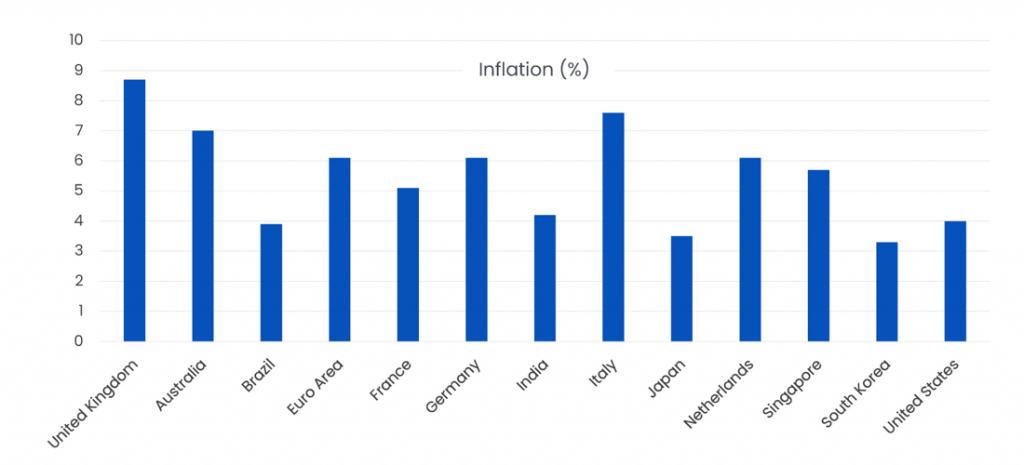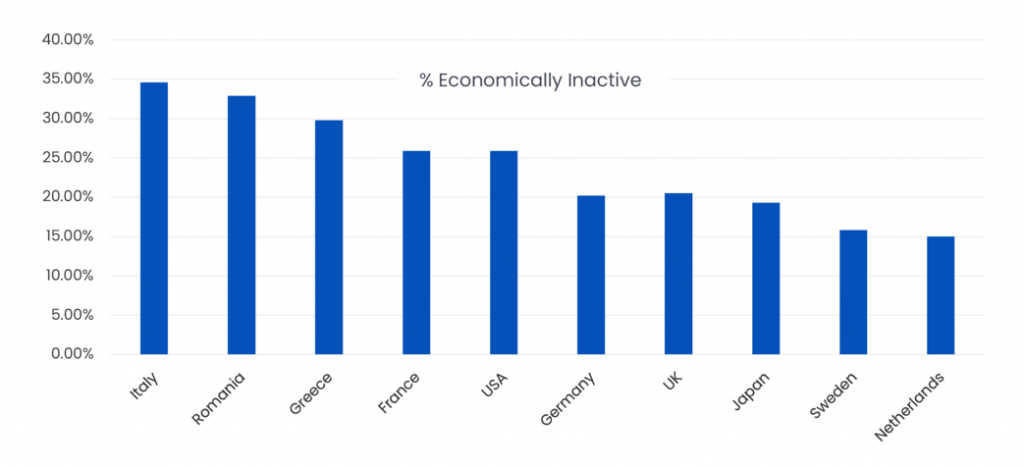Why diversity stats are less important than you think.
A couple of weeks ago, we delivered a
report for a major consumer goods
the company which wanted to know what
its competitors are doing in the
diversity space.
As one of the world’s leading talent
intelligence providers, we do plenty of
such reports. But what was unusual about
this one was our client’s relative lack of
interest in statistics. Naturally, they were
interested to know how their diverse
representation stacked up against
industry averages, but they realized this
wasn’t the be-all and end-all of the issue.
And they’re right.
Diversity statistics are a snapshot in time.
They tell you how you’re doing today, not
how you’ll fare tomorrow. They also fail to
tell a story. Say your stats are looking
good – did you fluke it or are you actually
doing something right? If so, what?
In any case, diversity stats are for HR
leaders. Shouldn’t the main thrust of DEI
activity be minority groups themselves?
Rather than obsessing over, say,
percentages of female leaders,
companies need to be asking themselves
about the everyday working experience
they offer women at every level.
Which leads us back to our client…We
like to think they’re happy with their report.
We reckon we did a very thorough job –
but only because the company so skillfully
defined the parameters of our research.
Yes, they wanted to know figures, but they
also wanted to learn about support
groups, cross-industry alliances, training,
language, schools outreach, university
programs, personal testimony from
minority groups, speeches by senior
leaders, C-suite support, company ethos
and a whole range of other insights that
don’t show up on a spreadsheet…
The best DEI leaders know that diversity
is a cultural issue. Only by understanding
the activity of fellow corporates and
society at large can any one company
craft an EVP which genuinely caters
to all its employees.
Achieve that, and the stats look
after themselves.
Check out our article on Who Cares Win here.
Also, check out our Article Don’t Worry, Be Happy here.
The World According to WhiteCrow
As the world’s largest sourcing and recruitment company, WhiteCrow works with clients
across multiple geographies and sectors. So a brief glance at what we’re working on
ought to provide a clue to what’s going on in the wider market…
It’s official. Updated growth figures from
May show that Germany – supposed
a powerhouse of the European economy
– is in recession. Plenty of other
countries around the world are only a percentage point or two away from
the same fate.
▪ But whereas previous global recessions
have been characterized by high
unemployment, labour levels
worldwide are actually very good. The
the jobless rate in the UK is at a historically
low 3.8% while in the US it’s even lower
at 3.7%. That’s good for WhiteCrow
because it means companies need our
expert advice on finding and engaging
increasingly scarce candidates.
▪ So it’s not surprising that the number
of jobs, we worked on during the last
quarter dipped only very slightly, down
from 2,420 to 2,408. Average jobs per
the month was 802, a statistically
insignificant change on last quarter’s
figure of 807.
▪ Our Investment Banking and Energy
clients are keeping us particularly busy.
One well-known bank has 109 jobs
active with us at the moment, while a
global oil & gas client notched up
111 requisitions over the last quarter.
That surely speaks to the relatively
buoyant stock prices across the
financial services and energy sectors.
▪ But even if companies have lots of jobs
to fill, worsening economic conditions
overall are leading to tighter
recruitment budgets. In other words,
TA leaders need to do more with less.
That’s also reflected in our data. With
23% of projects being research related
(up from 18% in Q1) it seems recruiters
are hungry for data and insights
that can help them hire better, faster
and smarter.
Also, study our article on Money Talks here.

Understand How you can Be an Agile Shape Shifter here.

Talentomics
Covid. Cost of living. Ukraine. Whatever your view on the big issues of the day, we can all
agree these are unpredictable times. That’s a nightmare for workforce planning. So now
more than ever Talent teams need to be across the numbers. Below, we share a
selection of economic charts and comment briefly on their implications for recruitment.
Inflation

With Fed Chairman Jerome Powell
recently commenting that the fight
against US inflation “has a long way
to go”, we thought we’d take a look
at what’s happening to prices
across the world.
▪ In many cases, the graph is going in
the right direction. But only very slowly.
In the UK, core inflation is actually up.
But weren’t we told inflation was largely
the result of the energy price hike that
followed Putin’s invasion of Ukraine?
Energy prices have been falling for
sometimes, yet consumers are still
struggling to afford everyday items.
It increasingly looks like there could have
been other factors at play such as the
huge amounts of quantitative easing
we’ve seen over the last few years.
▪ Economists can argue about the precise
causes, but if Jerome Powell is right, we
can expect candidates to be pushing
hard for wage increases. Younger
candidates will be worried they can’t pay
their bills, but even highly paid senior
candidates – many of whom will be
homeowners experiencing massive hikes
in their mortgage payments – are likely
to take a tough negotiating stance.
Study our article on “Is Hybrid Working?” here.
Economic Inactivity per Country

▪ Since COVID, the number of people
who are neither at work nor looking for
work has increased in nearly every
country around the world.
▪ There are lots of suggested reasons for
this economic inactivity. But one that
should concern TA leaders more than
any other is an increase in mental
health cases. In the UK, monthly
sickness benefit claims have doubled
post-pandemic and mental health is
behind 41% of them.
▪ That begs the question of why so many
people are struggling with their mental
health. Could it be that the lockdown itself
is the cause? It’s interesting to note that
Sweden and Japan – neither of which
countries instituted a strict lockdown
– occupy two of the bottom three
places in our graph.
▪ Regardless, TA professionals – many of
who have done such great work
nurturing inclusive, neurodiverse
workplaces – have a key role to play
in tackling the epidemic of mental
health cases. Otherwise, the recovery
from COVID could be long and slow
for everyone.
Know what is Candidate Experience and What Companies Get Wrong!
Diversity and Outsourcing

Above we have listed the top 10 most
diverse countries according to
Stanford professor James Fearon’s
peer-reviewed analysis.
▪ What is interesting is that none of
these countries are particularly
recognizable as an offshoring centre.
Maybe South Africa, but that only
creeps in at 9th for linguistic diversity.
You’d think that with offshoring and
diversity being such key components
of most companies’ global expansion
strategies, there’d be a more visibly
joined-up approach to both issues.
To be fair, two popular outsourcing
locations are India and the Philippines, each
of which ranks quite highly on Fearon’s
lists. But other well-known outsourcing
hubs don’t fare so well. These include
China (155th by ethnicity and 148th by
language), Poland (164th and 178th)
and Vietnam (135th and 122nd).
▪ Obviously, a lot of the countries on
Fearon’s lists are riven by conflict, but
others – such as Togo or Zambia – are
probably worth a look for big companies
looking to globalize operations without
denting their diversity statistics.
Also, check out our Executive Solutions here.
Quote of the Quarter
There’s an awful
lotta conversations.
This was said to us (with an eye roll) by a
senior planning professional at a
well-known consumer goods company.
She was referring to the difficulty of getting
anything is done in her heavily matrixed
organization. The reason she was talking
to us at all was because she’d become so
exasperated by her employer’s
crisscrossing reporting lines that she’d
decided to move to another company.
This demonstrates a huge operational risk.
In short, the complexity of the design. Of course,
the bigger a company becomes, the more
elaborate its structure will necessarily be.
But too much overthinking and you can
drive the best people away.
The first line of defence here is Talent
Acquisition. By understanding how
organizational design affects the disposition
of employees, TA leaders can help craft
genuinely people-centric structures. These,
in turn, will drive better business outcomes
and higher talent retention rates.
Our complete “Resources from Industry Experts” is now available here.

Also, check out market insight and intelligence from our resources.
Wordplay
Like any industry, recruitment has its lexicon of odd words and phrases. The best of these serve to illuminate complex topics; the worst merely confuse and obfuscate.
As for the rest, well, let’s take a closer look…

Check out the first part of our series with Arvind Sachdev here.
Iteration
itərei∫ən
noun
Time was, you never heard this word
outside of a mathematics seminar. Then,
a few years ago, it slipped into the corporate
conversation as a variant on ‘version’ or
‘case’. Now it’s everywhere. Like Japanese
knotwood. The problem is, it’s usually
used wrongly. The word actually has two
meanings. One is the repetition of a
process. The other is a mathematical
procedure that is adjusted for the
results of a previous application. So a
sentence like “This is the third iteration of
the report” would be wrong – there’s no
the process being repeated and certainly not
one with learnings applied from previous
applications. Of course, there’s also
iteration’s evil sister ‘iterative’ – a word
much beloved by recruiters – but we’ll
leave that for another newsletter.
In summary, iteration doesn’t mean
version. Version means version.
Let’s use that.
Contact
To discuss any of the issues raised in this month’s newsletter or to explore how
WhiteCrow Research can help with any of your talent insight and recruitment
needs, please contact us.
